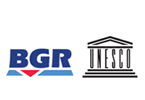Groundwater Resources of Africa
Background:
The map "Groundwater Resources of Africa 1 : 12 500 000" depicts the current status of WHYMAP´s groundwater resources mapping in Africa, prepared for the 7th Africa Water Week 2018 in Libreville (Gabon). It contains novel features, such as cross-sections and regional transboundary hydrogeological maps, bringing together generalised overview maps and regional hydrogeological studies, thereby adding additional value by including spatial information at a higher resolution in regions where ongoing BGR technical cooperation projects are taking place.
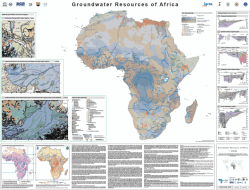 Map "Groundwater Resources of Africa"
Map "Groundwater Resources of Africa"
These regional mapping activities methodologically follow the spirit of the development of the International Hydrogeological Map of Europe (IHME1500), the only harmonised, pan-European dataset at a scale of 1 : 1 500 000. For the IHME1500, a lithological classification scheme was developed at BGR (Duscher et al., 2015) and combined with the Standard Legend for Hydrogeological Maps (SLHyM) of Struckmeier & Margat (1995). The regional maps transfer this European approach to groundwater resources mapping in Africa. These medium-scale maps are a further step to regional-scale integrated water resources planning and allow specific analyses, such as vulnerability assessments of groundwater resources to climate change and pollution.
The legend:
The legend of the main map largely follows the SLHyM. However, the legend differs slightly depending on the function of the general philosophy and purpose and is adapted to the scale of the map. The concept of three main colours has been maintained although their meaning has been slightly changed.
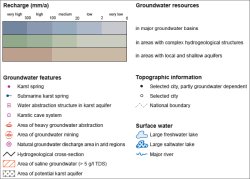 Legend of the map "Groundwater Resources of Africa"
Legend of the map "Groundwater Resources of Africa"
Blue colour is used for large and rather uniform groundwater basins covering about 41 % of the African land surface (aquifers and aquifer systems usually in large sedimentary basins that may offer good conditions for groundwater exploitation). The intensity of blue colour decreases from dark blue in high recharge areas (generally more than 150 mm per year) to medium blue (generally between 150 and 15 mm per year) and to light blue symbolising groundwater basins receiving very little recharge (generally less than 15 mm per year). This latter category is merely suitable for groundwater mining.
Green colour symbolises hydrogeological environments of complex geological structure. These are areas in heterogeneous folded or faulted regions where productive aquifers (including karst aquifers) may occur in close vicinity to non-aquiferous strata that cover approximately 18 % of the land. In these areas remote sensing techniques as well as detailed ground surveys coupled with spring and stream flow analysis may help identify zones of high yielding aquifers.
Brown colour outlines areas with local and shallow aquifers in which relatively dense bedrock is exposed to the surface. In these areas groundwater is comprised to the alteration zone of the bedrock and overlying shallow layers of weathered bedrock, which may be productive locally, covering almost half of the African territory (41 %).
Groundwater and the importance of transboundary aquifers in Africa:
Up to 75 % of Africa´s population uses groundwater as the main drinking water source, and groundwater is important for rural livelihoods, livestock rearing and urban water supply. Most of Africa´s large aquifer systems are transboundary. Seventy-two transboundary aquifers have been identified in Africa. They underlie 40 % of the continent, where approximately 30 % of the population lives, often in arid or semi-arid regions (Nijsten et al., 2018). The number of transboundary aquifers that have been identified has been increasing steadily since the first ‘Transboundary Aquifers of the World Map’ was released by BGR and UNESCO in 2006. Since then, the delineation of existing transboundary aquifers has been continuously refined and it is likely that new transboundary aquifers will still be identified in the future.
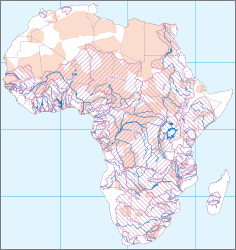 River and groundwater basins and transboundary aquifer systems in Africa
River and groundwater basins and transboundary aquifer systems in Africa
Governance and management of transboundary aquifers in Africa:
World-wide, management of transboundary aquifers remains challenging as groundwater has been traditionally considered a national matter. Monitoring of the Sustainable Development Goal (SDG) indicator on transboundary waters (indicator 6.5.2) indicates that Africa is one of the continents with the highest proportion of transboundary waters under an operational arrangement (UNESCO & UNECE, 2018) including the large groundwater resources of the Nubian Sandstone Aquifer System (NSAS), the North-Western Sahara Aquifer System (NWSAS), and the Stampriet Transboundary Aquifer System (STAS). A memorandum of understanding was signed in 2014 for the establishment of a consultation mechanism for the Iullemeden, Taoudeni/Tanezrouft Aquifer System (ITTAS) but has not entered into force yet.
Most operational arrangements related to transboundary aquifers are combined agreements that cover both river or lake basins, and aquifers. Given that aquifers and river/lake basins do not necessarily coincide, the most appropriate body to oversee the management of a transboundary aquifer may not necessarily be a river or lake basin organisation (if existent). However, these international arrangements and institutions play a crucial role in promoting cooperation over transboundary aquifers through action programs.
Transboundary, medium-scale hydrogeological maps for improved groundwater management:
The drought-prone Sahel region experiences an ongoing and growing demand on groundwater-based water supply. Population growth, climate dynamics and global warming have led to increased groundwater extraction for drinking water, livestock husbandry, and agriculture. Government, non-government and private organisations have railed up the exploitation of groundwater resources but lack reliable baseline data on the extent and productivity of aquifers. Medium-scale maps provide the necessary hydrogeological information for regional planning and strategic groundwater management. BGR prepared such regional hydrogeological maps in West and Central Africa in the context of two technical cooperation projects supporting the Lake Chad Basin Commission (LCBC) and the Niger Basin Authority (NBA), respectively. The inset maps visualise the results of the two main processing steps: i) map harmonisation and attribution of lithological units (map A) and ii)
regionalisation of hydrogeological parameters and assignment of aquifer productivity classes (maps B and C).
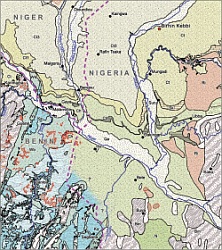 Harmonised lithological map of the border region of Benin, Niger and Nigeria
Harmonised lithological map of the border region of Benin, Niger and Nigeria
Harmonised lithological map (map A):
Fundamental for any regional analysis is a unitary and consistent geological base map. Available geological maps differ by scale, detail, extent, and denomination of geological units with particular discrepancies occurring in transboundary areas. Harmonisation comprises both spatial and geometric unification along map sheet boundaries as well as a semantic generalisation including attribution of lithological units following a common classification scheme. The present map follows the hierarchical lithological aggregation scheme of the IHME1500 that allows differentiation on five aggregation levels starting with the degree of consolidation followed by a taxonomic classification based on main and accessory components. For overview purposes, only the main components as recorded in the IHME1500 level 3 are displayed. Based on surface geology maps, the resulting map reflects the lithology of the uppermost groundwater bearing layer. To expose the solid geology of the uppermost aquifer, cover layers have to be removed from maps depicting drift or superficial deposits.
Lithological harmonisation draws on available geological information and uses expert knowledge to unify differing lithological descriptions. Challenging are large discrepancies in transboundary regions where, due to the lack of geological field studies, different geological units have been mapped. The harmonisation approach contributes to identify such lacunae in our geological knowledge and highlights hotspots needing further scientific investigation.
Map A shows the harmonised lithology of the transboundary aquifer system of the Iullemeden-Sokoto-Kandi basins in the border region of southern Niger, north-eastern Nigeria and northern Benin. The unitary lithological information is fundamental and starting point for the ensuing hydrogeological assessment.
Aquifer productivity map (maps B & C):
The lithology of the uppermost aquifer can be derived from the harmonised lithological maps and allows a first differentiation of aquifer types, which is the basis for a productivity classification according to the SLHyM. Their categorisation scheme separates on the x-axis aquifers of fissured and intergranular flow. On the y-axis, it differentiates between classes of high, moderate and limited productivity, and of no groundwater resources.
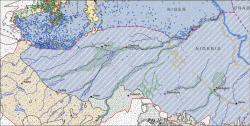 Aquifer productivity map of the transboundary Komadugu-Yobe region (Niger, Nigeria)
Aquifer productivity map of the transboundary Komadugu-Yobe region (Niger, Nigeria)
To add a quantitative component to the individual productivity classes, a classification methodology proposed by Krásný (1993) was adopted relating qualitative productivity classes to absolute values of transmissivity, specific capacity and yield. Available field measurements were used to first categorise the productivity of each borehole and then to assign a mean productivity class to each lithological unit (map B). Map C applies a slightly modified approach after Nkhoma & Bäumle (2007) and Krásný (1993).
Additionally to a harmonised aquifer lithology, maps B and C present the productivity classes of the uppermost aquifer for the transboundary regions of the Komadougou-Yobe basin in north-eastern Nigeria and south-eastern Niger and of the provinces Salamat and Vakaga in south-eastern Chad and northern Central African Republic, respectively.
Acknowledgements:
The regional maps were elaborated within the technical cooperation framework of BGR advising the superregional commissions on surface water and groundwater management of the Niger Basin (Niger Basin Authority, NBA) and Lake Chad (Lake Chad Basin Commission, LCBC), funded by the Federal Ministry for Economic Cooperation and Development (BMZ; project id’s 2013.2465.6 & 2014.2272.4).
Recommended citation:
BGR & UNESCO (2018): Groundwater Resources of Africa – Special edition for the 7th Africa Water Week, 1 : 12 500 000. Berlin/Paris.
References:
- DUSCHER, K., GÜNTHER, A., CLOS, P., PHILLIP, U. & STRUCKMEIER, W.F. (2015): The GIS layers of the International Hydrogeological Map of Europe 1 : 1 500 000. - Hydrogeology Journal, 23(8): 1867-1875; doi: 10.1007/s10040-015-1296-4
- KRÁSNÝ, J. (1993): Classification of Transmissivity Magnitude and Variation. - Ground Water, 31(2): 230-236.
- NIJSTEN, G.-J., CHRISTELIS, G., VILHOLTH, K., BRAUNE, E. & GAYE, C.B. (2018): Transboundary aquifers of Africa: Review of the current state of knowledge and progress towards sustainable development and management. - Journal of Hydrology: Regional Studies 20: 21-34.
- NKHOMA, J. & BÄUMLE, R. (2007): Groundwater resources for Southern Province, Zambia – A manual with explanations for the use of the hydrogeological maps. - Department of Water Affairs (DWA), Zambia & Federal Institute for Geosciences and Natural Resources (BGR); 20 pp; Hannover - Lusaka (Printech). (PDF, 2 MB)
- STRUCKMEIER, W. F. & MARGAT, J. (1995): Hydrogeological Maps - A Guide and a Standard Legend. – International Association of Hydrogeologists (IAH), Int. Contrib. to Hydrogeol. 17: 177 p.; Heise (Hanover). (PDF, 10 MB)
UNESCO & UNECE (2018): Progress on Transboundary Water Cooperation: Global baseline for SDG indicator 6.5.2. Special edition for the 2018 World Water Week in Stockholm. Available at: https://www.unwater.org/publications/progress-on-transboundary-water-cooperation-652/
Contact
